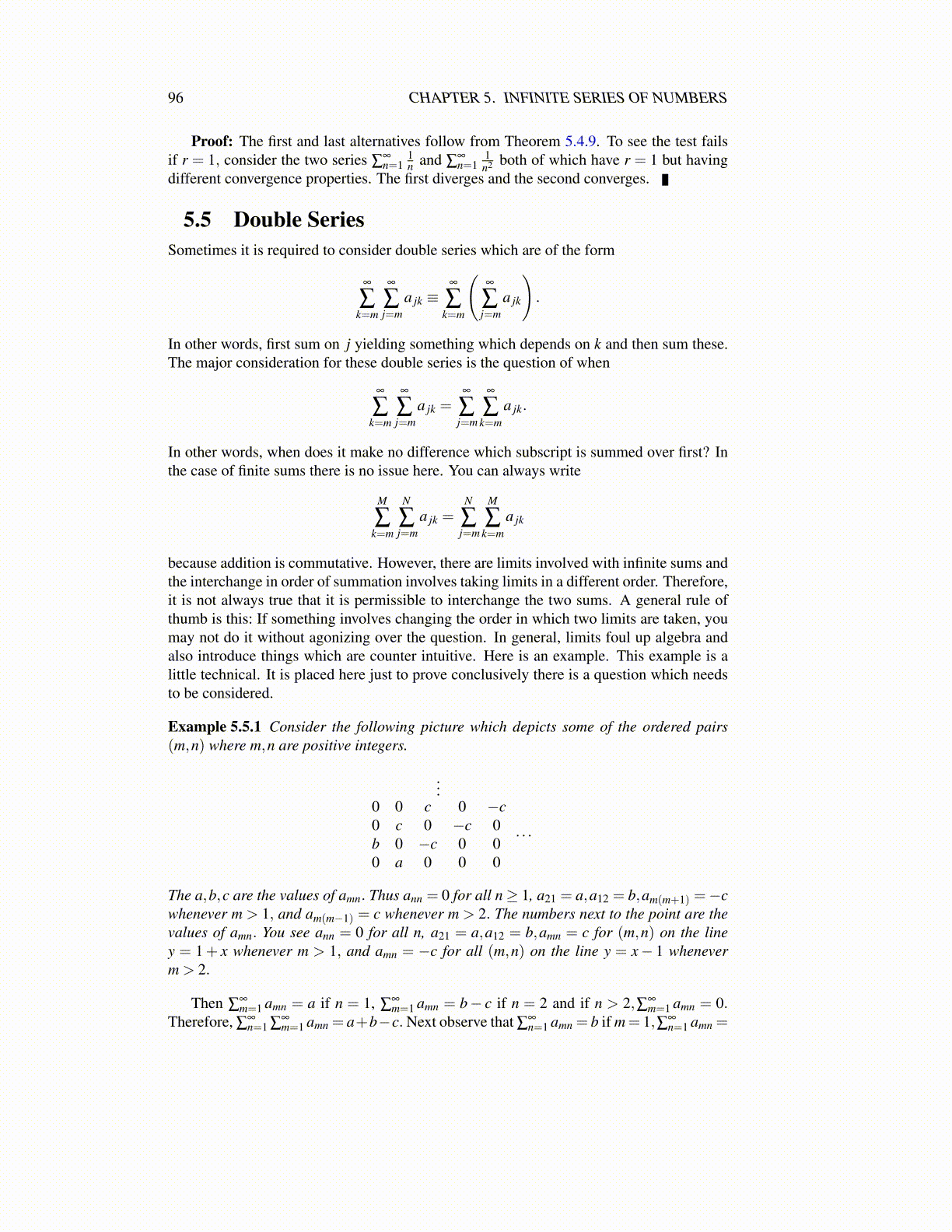
96 CHAPTER 5. INFINITE SERIES OF NUMBERS
and so
Re∞
∑j=r
∞
∑i=r
ai j =∞
∑j=r
∞
∑i=r
Reai j =∞
∑i=r
∞
∑j=r
Reai j = Re∞
∑i=r
∞
∑j=r
ai j
Similar reasoning applies to the imaginary parts. Since the real and imaginary parts of thetwo series are equal, it follows the two series are equal.
One of the most important applications of this theorem is to the problem of multiplica-tion of series.
Definition 5.5.5 Let ∑∞i=r ai and ∑
∞i=r bi be two series. For n≥ r, define
cn ≡n
∑k=r
akbn−k+r.
The series ∑∞n=r cn is called the Cauchy product of the two series.
It isn’t hard to see where this comes from. Formally write the following in the caser = 0:
(a0 +a1 +a2 +a3 · · ·)(b0 +b1 +b2 +b3 · · ·)and start multiplying in the usual way. This yields
a0b0 +(a0b1 +b0a1)+(a0b2 +a1b1 +a2b0)+ · · ·
and you see the expressions in parentheses above are just the cn for n = 0,1,2, · · · . There-fore, it is reasonable to conjecture that ∑
∞i=r ai ∑
∞j=r b j = ∑
∞n=r cn and of course there would
be no problem with this in the case of finite sums but in the case of infinite sums, it isnecessary to prove a theorem. The following is a special case of Merten’s theorem.
Theorem 5.5.6 Suppose ∑∞i=r ai and ∑
∞j=r b j both converge absolutely1. Then(
∞
∑i=r
ai
)(∞
∑j=r
b j
)=
∞
∑n=r
cn
where cn = ∑nk=r akbn−k+r.
Proof: Let pnk = 1 if r ≤ k ≤ n and pnk = 0 if k > n. Then cn = ∑∞k=r pnkakbn−k+r.
Also,∞
∑k=r
∞
∑n=r
pnk |ak| |bn−k+r|=∞
∑k=r|ak|
∞
∑n=r
pnk |bn−k+r|
=∞
∑k=r|ak|
∞
∑n=k|bn−k+r|=
∞
∑k=r|ak|
∞
∑n=k
∣∣bn−(k−r)∣∣= ∞
∑k=r|ak|
∞
∑m=r|bm|< ∞.
Therefore, by Theorem 5.5.4
∞
∑n=r
cn =∞
∑n=r
n
∑k=r
akbn−k+r =∞
∑n=r
∞
∑k=r
pnkakbn−k+r
=∞
∑k=r
ak
∞
∑n=r
pnkbn−k+r =∞
∑k=r
ak
∞
∑n=k
bn−k+r =∞
∑k=r
ak
∞
∑m=r
bm
1Actually, it is only necessary to assume one of the series converges and the other converges absolutely. Thisis known as Merten’s theorem and may be read in the 1974 book by Apostol listed in the bibliography.